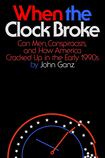
I like to joke that I am responsible for Ross Perot’s withdrawal from the 1992 US presidential election. In my final year of high school, a small group of friends and I calling ourselves the Anti-fascist Youth League of Virginia marched on the Perot headquarters in our hometown. In response, the Perot campaign invited us to meet the candidate. Yet shortly thereafter Perot suddenly left the race despite leading in the polls. He claimed it was because Republicans would smear his daughter at her wedding with a doctored photograph. But we know the real reason: he was afraid to face us teenagers.
I used to think of this story as merely illustrating youthful high jinks, but since the rise of Trump I think maybe we were on to something. Perot, after all, was an unhinged billionaire celebrity who promoted a brand of authoritarian populism that appealed to voters who felt that the United States had lost its way. When he later re-entered the race that autumn, he won almost 19 per cent of the vote, a historic number for a third-party candidate that reflected widespread discontent with political elites.
In his superb new book, John Ganz examines the historical moment of the early 1990s that produced the Perot campaign and finds in it the roots of Trumpism. When the Clock Broke offers a compelling examination of a neglected and revealing period in American history. It is also one of the most entertaining history books I have read in years. Ganz has a novelist’s skill at managing character, pacing and plot, as well as a great eye for details that are telling, bizarre and hilarious.
If When the Clock Broke were a novel, you would have to class it as a black comedy. It is a story of how “oddballs, cranks, and even crooks capture[d] the public imagination more than staid figures of respectable authority”. The early 1990s were supposed to have been a time of triumph, with the US having won the cold war. Indeed, President George HW Bush was riding high in the polls in early 1991, with an unbelievable 87 per cent approval rating following the successful Gulf War. But as Ganz notes, “In the national consciousness, Saddam Hussein’s ouster from Kuwait had the staying power of a made-for-TV movie.” The debt-fuelled boom of the Reagan years came to a screeching halt in a deep economic recession, leaving millions out of work.
READ MORE
While Ganz paints a superb picture of the zeitgeist, it is not always clear how all the portraits add up
In the short-term Bill Clinton benefited, riding the mantra “the economy, stupid” to victory in 1992. But the radical right also fed on the resentment caused by economic dislocation. The cold qar had a disciplining effect upon conservatives, committing them to support the large effort needed to defeat international communism. But with the collapse of the Soviet Union, older versions of conservatism resurfaced that sought to put “the United States first” by combining isolationist foreign policy with xenophobic efforts to assert the primacy of white male Christians within the US. Reagan’s sunny optimism, having been exposed as fraudulent, was replaced with attempts to create a “‘negative solidarity’ of knowing who you hated or wanted to destroy”.
When the Clock Broke is structured around a series of finely etched vignettes that reveal the deeper undercurrents of this historical conjuncture. Ganz brilliantly weaves the structural changes in American politics and society into his portraits of the right-wing figures who rose to prominence in this period. Some of his cast of characters are well-known, others less so.
Among them are Pat Buchanan, who mounted a challenge to Bush in the Republican primary promising to “take back our country”, including a pledge to build a wall at the Mexican border; David Duke, the former Klansman and Nazi who won a majority of the white vote (while losing overall) in races for US senate and governor in Louisiana; Rush Limbaugh, the abrasive and popular conservative talk radio host; and Daryl Gates, who ran the Los Angeles Police Department as a “private, unaccountable fiefdom” rife with racism. Gates was the man most responsible for the worst civil disturbance in the US in more than a century when LA police officers were exonerated of the beating of an African-American, Rodney King, despite publicly available videotape proving their guilt.
While Ganz paints a superb picture of the zeitgeist, it is not always clear how all the portraits add up. At times it is difficult to follow the chronology. He also understates the extent to which right-wing politics was fuelled by antagonism to feminism and LGBTQ rights. And, while obviously interested in finding the origins of our own time, Ganz leaves it to readers to fill in the gap for the quarter-century between the early 1990s and Trump’s election.
Yet the relevance of his history is undeniable. Because while the likes of Perot, Buchanan, and Duke lost “in the short term, they brought to the surface an intense anguish in American life, a politics of national despair that has returned with great force”. Come November, with the dangerous and ridiculous Trump well-positioned to recapture the White House, we may again be laughing through our tears.
Daniel Geary is Mark Pigott associate professor in American history at Trinity College Dublin














